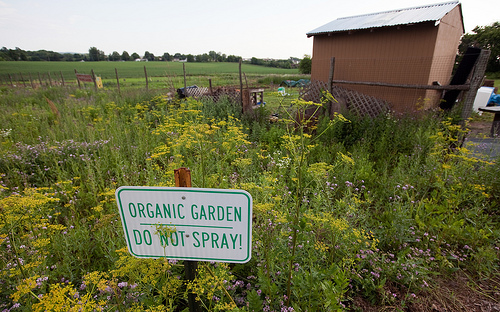
by Mackenzie Kupfer
Many people worry that organic gardening is more expensive than non-organic. However, like anything else in life, it is only as expensive as you make it. By being circumspective, you can save more money by gardening organically than you would otherwise.
Here are some ways to make this health- and environment-friendly trend save you money.
ECO-FRIENDLY SUPPLIES
It’s possible to be green from the get-go. Even your gardening supplies can be eco-friendly. Instead of using plastic meshes to help maintain moisture in your soil, try biodegradable coco liners, made from coconut fibers.
Cedar mulch often doesn’t degrade well, so try asking your local tree-trimming businesses for their branches to turn into healthier mulch.
Even your planters and raised beds can leave a smaller footprint on both the planet and on your wallet: look for any “junk” that catches your eye. I’ve been using horse water troughs as planters for years and painted them recently. You can get a lot of beauty for very little cost!
FOOD & FLOWERS
If you’re a vegetable gardener, the most obvious thing you’ll save money on once you start growing successfully is produce. At the store, you may notice that pretty much all organic produce is priced higher than other foods.
With flowers, too, the sellers with eco-friendly methods are able to put a higher price on their wares.
I take this as a good sign because it means that people highly value things that are good for the earth.
However, I choose to grow my own which, is significantly cheaper. For cents on the dollar, I can provide vegetables and herbs to my family and flowers for my home and my loved ones.
COMPOST
For those who don’t know, compost is a mixture of various organic components used to raise the quality of soil. You can make it yourself!
I’d recommend starting your compost heap in your backyard; a new gardener trying one indoors might be a stinky mess.
The layering of “brown” and “green” materials is key. Brown materials, things like decaying leaves or sawdust, provide carbon to your mixture while green materials, things like grass clippings and your leftover food from dinner, provide nitrogen.
The careful combination of water on each layer, agitation caused by turning over the pile with a pitchfork, and heat levels (that you monitor) causes the cheap concoction to break down into a lovely loam that will nourish your garden.
For free bits of compost-y goodness, scout out your area.
If you live on the coast, snag some seaweed. Pester neighbors for their unwanted leaves in fall. Coffee houses might give you their grounds and even fish markets might give you the non-edible parts that really add nutrients to your masterpiece.
PESTICIDES
Pesticides tend to contain harmful chemicals. But organic alternatives tend to be pricy. Fear not, because there are green ways to ward off unwanted garden intruders without busting the bank.
For starters, weeds can be killed just as effectively with a mixture of vinegar and salt diluted in boiling water as they can by brand-name pesticides. Also, the benefits of weeding your garden by hand are numerous, so take some time and elbow-grease to do your part.
For bugs, you can use Neem oil (an organic bug deterrent) or release things like ladybugs into your garden to eat up all the unwanted aphids.
For animals like deer, you can do what my Nana used to and hang old pie-tins from a string on a pole to scare them away when the wind blows.
Or you can try one of the many homemade deer-repellent brews I’ve found around the net: a mixture usually with water, egg, hot sauce, and garlic sprayed over plants apparently works!
SEEDS
The most conscientious plant-sellers can afford to put a high-premium on their seeds. And making an investment in them for the first season might be the best way to go.
But afterwards, scrupulous harvesting of seeds from your resulting plants means that you’ll be the source of all of your future seeds. Dry your collected seeds on parchment or paper bags until there isn’t any moisture to cause preemptive growth or molding.
Storing them in air-tight containers in a temperature-controlled place in your home will ensure they’re ready to go next planting season. Remember to date your containers! Hopefully you’ll have so many, it will be hard to keep track.
COMMUNITY
One of the best ways to get your garden growing on a budget is to find like-minded people. Friendly organic gardeners are almost always willing to give you some of their extra seeds or even entire plants.
Help people in their gardens in exchange for a share of a crop you haven’t yet mastered. You’ll be able to learn from their experiences and get some of your own before you try to grow something of your own. Sharing supplies and tips is just one way to cut down on how much you spend and also boost how much fun you have in your garden.
Whether you’re acquiring manure from farming friends or gossiping about the best businesses to get free goodies from, your community is your greatest asset. So be sure to return the favor and be a resource, yourself. Spread the wealth!
(Mackenzie Kupfer has been a lover of all things green since the age of six when she began gardening with her Nana. In her free time, Mackenzie enjoys attending garden shows, hiking, and collecting ceramic tea sets.)






Be the first to comment